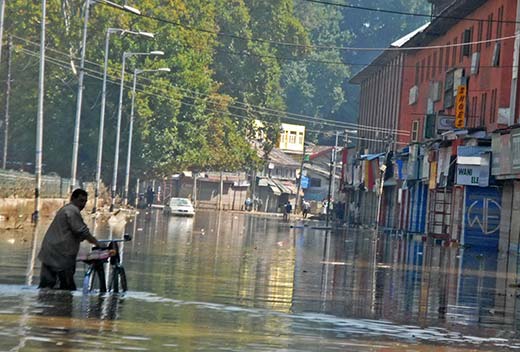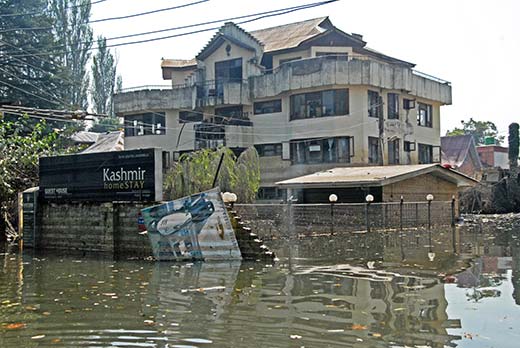When all others modern means of connectivity got washed out in recent floods it was the good old radio set that helped people stay in touch. Hakeem Rouf Qadir tells how a century old technology kept modern man’s hopes afloat

During the century’s worst floods, when road connectivity, power supply and almost all communication links had snapped; when hapless people were miserably craving for help and whereabouts of their loved ones; when the entire government was missing; when there was none to listen to peoples’ pleas and cries; it was the good old radio that connected distressed and marooned people of Kashmir.
Amid this connectivity crisis, radio acted as a source of solace, a life saving link, helping separated family to unite.
It played a yeoman’s role in rescuing people by airing thousands of messages every day including weather and safety advisories. “For days altogether, I was anxiously awaiting for the news of my relatives who live in down town, Srinagar. When all contacts failed, finally an announcer on the radio gladdened me by airing a message that they had taken refuge inside Makhdoom Sahab shrine,” says Dr Muneeb ur Rehman, a resident of Nowgam, one of the worst hit areas located on the outskirts of Srinagar.
It was like old times: people, displaced from their homes, circling around a radio set, hoping to get some news about their loved ones. All of a sudden radio became one of the most prized possessions for people living in make-shift camps, or in their homes.
“It was only through radio that, after two days of anxious and painful wait, I came to know that my daughter, who was staying at Islamic University Hostel, is safe” says Mohammad Ashraf, who was worried about the safety of his daughter caught in the floods.
On September 4, Radio Kashmir Srinagar (RKS) started a special 18 hour live broadcast to read distress messages and e-mails sent by people from across Kashmir.
“We received thousands of messages everyday seeking help, giving suggestions, and informing about the rising water level in different areas,” says Talha Jahangeer, one of celebrated announcers at RKS.
At a time, when internet and other connectivity services got snapped, radio became a medium to transmit important information and advisories. “I want to suggest that the domestic animals be untied so that they may swim out to safer places. People can cut plastic water tanks at the centre, use mattresses and wooden planks and other floatable stuff to make make-shift boats,” read a message aired by RKS. Jahangir feels that these hasty and innovative techniques worked wonders for people, and in many cases helped them save their lives too.
Jahangir, who informed his mother about his safety through radio, recollects, “Most of the staff were themselves affected by the floods but still they preferred to serve the people.”
But on September 7, radio service had to be closed down temporarily. “I was on air when at 11 AM water started entering Radio Kashmir premises. By 4PM, it was already flooded inside the station and I announced closure of services till we make alternative arrangements,” recalls Jahangir.
“After closing the station, I waded through the knee high water to reach the place where I had parked my car,” remembers Jahangir.
Somehow Jahangir managed to get into his car and drive out. But, the moment he reached near Abdullah Bridge, a strong wave of water, that had breached the bund, hit his car. “I thought I will not make out alive. My car was sailing like a boat,” says Jahangir. “I left my car their and managed to reach my friend’s house at Naseem Bagh.”

After two days, on September 10, Shamshad Kralwari, deputy Director of Commercial Broadcasting Service (FM-102.6 MHz) a branch of Radio Kashmir, equipped with a microphone and a mobile phone turned a TV control room in to a radio studio. He became the voice of solace for the devastated people.
Even though his own house was inundated in 10 feet of water, he, with the help of some engineers who were airlifted from Delhi, established a makeshift transmission station in a room atop Shankar-Acharya hills where transmitters of Commercial Broadcasting service and Doordarshan are located. “I left my family, waded through the waters, changed boats several times and climbed the hilltop; it was a challenge to reach there. It took me six hours to reach Shankar Acharya,” says Kralwari. “It was a herculean task to establish a studio with very limited resources,” says Kralwari.
Once the station was set, Kralwari made announcements urging his colleagues to join him. “I was at Naseem Bagh when someone told me that radio had been restored and I am needed there,” Jahangir recollects. “I rushed to Gupkar and from there trekked the Shankar Acharya hills to join my fellow announcers.”
But keeping the service running despite entire city under water was a challenging job for Kralwari and his team. “We faced serious crisis in terms of food, water and diesel to run generators,” recalls Jahangir. Later, they were provided with some bottles of drinking water and eatables by the Army and DC Srinagar.
“The arrangement was not good enough for a radio station. It is a Television Control-room there at Shankar Acharya hills” admits Humayun Qaisar, who also waded through the deluge and walked for hours along the bund to reach the temporary station.
“It was a live programme but the set-up was not perfect. We had to manually play with the electrical wires and connections to set the things right,” says Qaisar.
“We slept on the cemented floor in a small room on mattresses provided by some casual labourers of Doordarshan,” says Qaisar.
But knowing the importance of their work in the light of floods, Qaisar and his colleagues kept the communication link alive by all means.
“There was no other way to communicate with each other, but through radio. And we knew the importance of our job,” says Jahangir.
“One day I received a message on my phone saying ‘we are around 40 volunteers in Tangmarg, tell us how we could be helpful’,” recalls Jahangir. “We advised them to be organized and careful, and try to save as many people as you can and work with the local administration.”
After some time Tehsildar of the same area called Jahangir and said that these volunteers have rescued three villages. Thus radio helped volunteers by acting as their guide telling them where their services are needed. It (radio) also helped dispel rumours, giving people hope in those difficult times.
A renowned psychiatrist while counselling victims through radio said, “Radio service acts as a great stress buster for panicked people during this moment of fear and grief.”
During those depressing days, radio was the only source of consolation for people marooned by the floods. It (radio) helped people reach different locations in and outside city by transmitting information about safe routes. “We were working as connector between those who had information and those who needed information,” says Jahangir.
Jahangir’s colleague Kralwari remembers one such emotional incident where a desperate elderly person reached Shankar Acharya Temple from Islamabad – some 50 kms from Srinagar – to get his message aired for his marooned daughter. His daughter was studying in Government Medical College, Srinagar. “I took a bus, then a boat, and then walked through rough waters to reach this place,” he told Kralwari.
“We assured him that we had reliable information about students from that college hostel being evacuated and taken to safer places,” recalls Kralwari. “Earlier that day he had made announcements regarding the rescue of these students through radio,” says Kralwari.
“Responding to the announcements, we were told by our listeners that the students were rescued on time and taken to Ganderbal, thanks to timely action by the principle of the college.”
The elderly man was satisfied that his daughter and other students are safe and sound.
It was because of these announcer’s continuous appeals that senior officers from the state administration started coming to the makeshift radio studio to guide people in their hour of need. Even Chief minister Omar Abdullah trekked to the hilltop more than once to stay in touch with the people. “It was a dreadful experience but we as a team are happy that we could help people in our small way,” says Jahangir.
Author is an ex-Student of Department of Botany, Jamia Hamdard, New Delhi. He can be reached at: [email protected]















